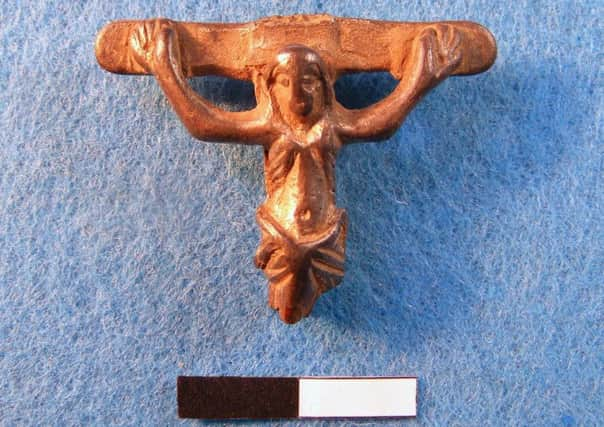‘Magnificent’ year for Scots treasure hunters


A total of 265 people reported objects to the Treasure Trove Unit between April 2013 and March this year.
Museums across Scotland were allocated 825 objects found by members of the public.
Advertisement
Hide AdThere were also 22 collections from digs by professional archaeologists, four of which attracted no interest from museums and were returned to the excavators.
The items found included a gold Merovingian tremissis coin at Coldstream in the Borders. The Merovingian dynasty was from ancient France, or Gaul, while tremissis was a currency of the late Roman empire.
Such coins were in use across England, but finding one in Scotland is highly unusual and this was the first of its type to be located north of the Border.
A Roman wine dipper – a small cup – was discovered at Hawick in the Borders, while an Iron Age strap mount, which would have decorated the trappings of a horse and chariot, was found at Dunbar in East Lothian.
Other finds included a mediaeval silver crucifix at Loch Leven in Perth and Kinross, and a 16th-century gold finger ring decorated with white enamel which was discovered at Roslin in Midlothian.
Catherine Dyer, the Queen’s and Lord Treasurer’s Remembrancer (QLTR), said: “The report confirms that this has been another magnificent year with some outstanding finds being reported, preserved and displayed in breathtaking museum collections around Scotland.
Advertisement
Hide Ad“Thanks should be given to the hundreds of members of the public who report their finds and in doing so assist in preserving the history of Scotland for all to enjoy.”
Some canister shot from Culloden in the Highlands was also unearthed, as were fragments of a bronze age sword blade found at Dundrennan in Dumfries and Galloway, and a Roman brooch located at Charlestown in Fife.
Advertisement
Hide AdThe past year’s finds were dealt with as 162 treasure trove cases, a rise of just under a third on the year 2012-13.
People who find objects are routinely given an ex gratia award to recognise their contribution.
In the past year, £50,070 was paid in such awards, with individual payments ranging from £10 to £5,500.
In eight cases, the finder chose to forgo their ex gratia award.
Treasure trove relates to what may be described as “portable antiquities” and can cover anything from stone and wood to metal and cloth which has lain concealed and is thought to be worth preserving for the nation.
The Crown is entitled to claim any finds made in Scotland, whether made by chance, by metal-detecting, field walking or archaeological excavation.
Advertisement
Hide AdUnauthorised removal or disposal of finds may be considered to amount to theft, as finds are the property of the Crown, not the finder or landowner.
The QLTR’s role includes deciding on the allocation of objects to museums and the payments of rewards to finders, acting on the advice of the Scottish Archaeological Finds Advisory Panel and with the support of the Treasure Trove Unit, which is based at the National Museum of Scotland.